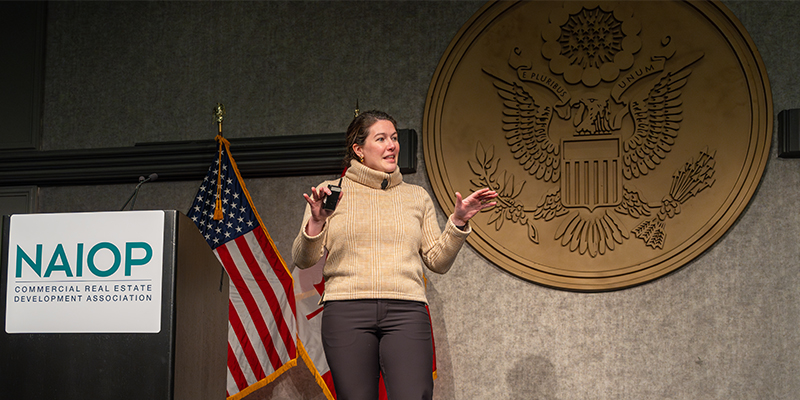The contentiousness of American politics is always a safe bet to grab headlines, especially in a presidential election year. However, Rebecca Rockey, deputy chief economist and global head of forecasting at Cushman & Wakefield, told attendees at NAIOP’s Chapter Leadership & Legislative Retreat in Washington, D.C., that some other less “exciting” issues are likely to be “top of the line” over the next two years for those in the commercial real estate industry.
In an information-packed keynote, Rockey highlighted several economic trends that will inform credit liquidity and the capital markets in 2024-2025.
Debt/Deficit
“One topic that is going to be very, very much in the circuit of conversations is what’s going on with the national debt and the national deficit,” Rockey said.
The U.S. deficit is nearing 6% of gross domestic product. “We can get into spending,” Rockey said, “but tax receipts are not growing in a way that is historically consistent with how they would in an economy that is as strong as what the GDP numbers suggest.”
Part of the challenge, she continued, is addressing some of the long-term deficit drivers, which tie in to the nation’s demographics and, more recently, the cost of interest, which is estimated to come in at $870 billion this year. “This will be the first time it exceeds defense spending, Medicare spending and so on,” Rockey said. “That won’t last long. Medicare will take back over in 2026, but let’s just say we have a debt problem.”
Tax Cut Expirations and Tax Expenditures
Rockey next discussed the Tax Cuts and Jobs Act (TCJA).
Fully extending TCJA rather than letting it sunset would cost $3.8 trillion. The discretionary budget of the U.S. government is under that number, Rockey pointed out, “so you can cut all discretionary spending and not even make the math work. … I do think it is quite likely that we see some of these things sunset because of the fiscal situation and the fact that it would drive those deficit numbers well higher.”
Tax expenditures related to the Inflation Reduction Act are another area of uncertainty, Rockey noted, especially if there is a President Donald Trump 2.0, because he has said that he doesn’t like these tax credits and wants to get rid of them. “That’s $386 billion that flowed through the tax system in the form of what we call tax expenditures. … You think, ‘Why does this matter too much?’ Well, this has been the thing that’s been helping to drive the resurgence in manufacturing investment. There were a lot of incentives here.”
Adaptive Reuse
Rockey next tackled the proposal to create a tax credit to incentivize adaptive reuse. However, “I think the elephant in the room is that it’s about dealing with the office problem that we have. We are over-officed [and] we are under-housed as a nation.” Estimates are that the housing supply deficit stands somewhere between 2 million and 4 million units.
Cushman & Wakefield data show record-setting negative absorption and the highest vacancy rate for office properties (19.7%) that the company has ever recorded.
The company is also tracking multiple forms of repositioning and reinvention for office properties. “The No. 1 thing is apartment conversions. … But guess what? We’re talking about 27 [million], 28 million square feet, and that’s very limited in terms of the housing supply that brings,” Rockey said.
She then shifted to a proposition for adaptive reuse and a reduction in office vacancy: “What if we were to target the weakest of the weak [assets]?” Rockey acknowledged that not every office building can support the conversion to multifamily, but in cases where that can happen: “We’re taking it to its highest and best use. You’re probably going to bring up the tax revenues that a government gets from that property … but you’re also going to reduce the pressure on the office market, which will reduce pressure on lenders and investors. It pays a lot of dividends.”
Using a proxy of buildings that are 50% or more vacant (but making sure to point out that not every building with that level of vacancy needs a conversion), Rockey played out the scenario further. “That’s the equivalent of saying let’s take out 8.5% of inventory from the office market and convert it to something else – hopefully multifamily. But whatever it is, what’s the impact on vacancy in that market, in the office sector, then in the existing office stock? … In some markets, it’s 10%, it’s almost 12%. [It’s] literally a decline in the vacancy rate of 11 percentage points when you get to Fairfield [County, Connecticut] or Brooklyn or Silicon Valley. These are material differences that can then start to create economic recovery conditions for the office market.”
Rockey said Cushman & Wakefield still expects negative absorption in the office market this year and into the first part of next year. “We’re not at peak vacancy. Anything we can do to expedite this will pay dividends to governments, and it pays dividends in terms of the pressure of financial valuations.”
Banks and Credit
That led Rockey to the topic of banks, which she said, “grease the wheels of all lending across the entire economy, but especially for commercial real estate.”
U.S. banks are in a tough situation because of three bank failures in 2023. Those issues were more about the banks’ asset structures on their balance sheets and deposit flight, Rockey said, but now the scrutiny has shifted to commercial real estate. “Banks were already on defense, and now on the commercial real estate loan book, they just want to protect what they have, they want to make sure it performs, and they will be selective about their engagements otherwise. They’re still tightening up their [under]writing standards. … This is where opportunistic capital, debt funds, private capital are likely to fill a void as we go through this.”
Basel III
Rockey concluded her keynote with an overview of Basel III, a set of global financial reforms that would increase capital requirements for banks of all sizes. Under the current proposal, U.S. banks with $100 billion or more in assets would have to increase their capital by 15% to 20%, while the level of capital at smaller banks would have to go up by about 10%. Although Rockey does not think the proposal will go through as currently written, she expects the U.S. will proceed with some form of Basel III in collaboration with global partners. The regulations could encourage further lending via shadow banks (and draw more scrutiny on these nonbank lenders) and increase borrower costs as a result.








